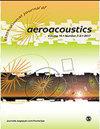SwirlProp: A tool for sound propagation and attenuation in swirling flows
IF 1.3
4区 工程技术
Q3 ACOUSTICS
引用次数: 1
Abstract
The current trends for next generation turbofan engines are towards shorter nacelles and increased distances between the fan and the outlet guide vanes. This leads to an overall reduction in lined surface areas as well as an increase in the relative importance of the interstage liner, which is the liner placed between the rotor blades and the stator vanes. So far most of the efforts have been on liners for intakes and bypass ducts. The interstage is different in that the liner is subject to a mean flow with a strong swirl component and shear. The SwirlProp code was developed to contribute to understanding and predicting the effect of the swirl on liner attenuation. The code is based on the linearized Euler equations together with the Ingard–Myers boundary condition. An eigenvalue problem is formulated and discretized using a finite difference method. The code is exhaustively compared against predicted values obtained by other methods for uniform, sheared and swirling mean flows and hard-walled and lined ducts. A cross-validation between SwirlProp and an in-house code from Rolls-Royce was carried out for a more realistic case. Also, details on the implementation of the boundary condition are proposed and details are presented.SwillProp:一种用于涡流中声音传播和衰减的工具
下一代涡扇发动机的当前趋势是缩短短舱,增加风扇和出口导叶之间的距离。这导致内衬表面积的总体减少以及级间内衬的相对重要性的增加,级间内衬是放置在转子叶片和定子叶片之间的内衬。到目前为止,大部分工作都集中在进水口和旁通管道的内衬上。级间的不同之处在于,衬管受到具有强涡流分量和剪切力的平均流的影响。SwirlProp代码的开发有助于理解和预测涡流对线性衰减的影响。该代码基于线性化的欧拉方程和Ingard–Myers边界条件。采用有限差分法对特征值问题进行了公式化和离散化。该代码与通过其他方法获得的均匀、剪切和旋转平均流以及硬壁和内衬管道的预测值进行了详尽的比较。SwirlProp和罗尔斯·罗伊斯的内部代码之间进行了交叉验证,以获得更现实的案例。此外,还提出了边界条件的实现细节,并给出了细节。
本文章由计算机程序翻译,如有差异,请以英文原文为准。
求助全文
约1分钟内获得全文
求助全文
来源期刊

International Journal of Aeroacoustics
ACOUSTICS-ENGINEERING, AEROSPACE
CiteScore
2.10
自引率
10.00%
发文量
38
审稿时长
>12 weeks
期刊介绍:
International Journal of Aeroacoustics is a peer-reviewed journal publishing developments in all areas of fundamental and applied aeroacoustics. Fundamental topics include advances in understanding aeroacoustics phenomena; applied topics include all aspects of civil and military aircraft, automobile and high speed train aeroacoustics, and the impact of acoustics on structures. As well as original contributions, state of the art reviews and surveys will be published.
Subtopics include, among others, jet mixing noise; screech tones; broadband shock associated noise and methods for suppression; the near-ground acoustic environment of Short Take-Off and Vertical Landing (STOVL) aircraft; weapons bay aeroacoustics, cavity acoustics, closed-loop feedback control of aeroacoustic phenomena; computational aeroacoustics including high fidelity numerical simulations, and analytical acoustics.
 求助内容:
求助内容: 应助结果提醒方式:
应助结果提醒方式:


